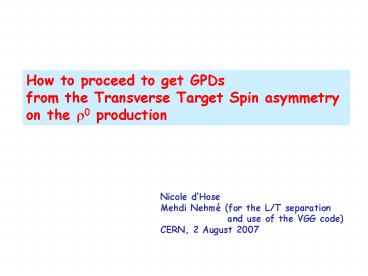How to proceed to get GPDs - PowerPoint PPT Presentation
1 / 21
Title:
How to proceed to get GPDs
Description:
The experiment on Li6D. TTSA measured on coherent D incoherent p or n non-exclusive bkgd ... H(x,0,t) = q(x) e t b 2 = q(x) / xa't (a'slope Regge traject. ... – PowerPoint PPT presentation
Number of Views:52
Avg rating:3.0/5.0
Title: How to proceed to get GPDs
1
How to proceed to get GPDs from the Transverse
Target Spin asymmetry on the ?0 production
Nicole dHose Mehdi Nehmé (for the L/T
separation and use of the VGG
code) CERN, 2 August 2007
2
The experiment on Li6D
TTSA measured on coherent D incoherent p or n
non-exclusive bkgd
coh
semi-excl
incoh
0.01 lt PT2 lt 0.5 296 615 evts 0.1 lt PT2 lt
0.5 109 244 evts coherent 3
incoherent 70 non exclusive 27
? Andrzejs presentation
? Guillaumes present study
3
The theory for meson production
- 1- Factorization for longitudinal photons only
- Suppression of transverse component ?T/?L
1/Q2 - For COMPASS kinematics ltQ2gt2GeV2 R
?L/?T 1 - 2- Coherent estimation ? Pire,Cano, Strikmann?
- Incoherent estimation ? Kroll, Goloskokov
(quark and gluon contribution) - Guzey (quark
and gluon contribution) - VGG (mainly
quark contribution) - and proton neutron contribution ?
4
quark and gluon enter at the same order of ?S
VGG
quarks
gluons
Diehl and Vinnikov (hep-ph/0412162) Evidence
for gluon contribution at xBj0.1
5
modelisation of GPD in the VGG code
Factorization H(x,?,t) q(x) F(t) Or
Regge-motivated t-dependence H(x,0,t)
q(x) e t ltb?2gt q(x) / xat (aslope Regge
traject.)
the GPD E is related to the nucleon helicity
flip
E
known Hq (x,0,0) q(x) unknown Eq
(x,0,0) eq(x)Aqqval (x) Bq?(x) (based on
chiral soliton)
2 sum rules
?q ? eq (x) dx
2Jq ? x (q (x) eq (x) ) dx
? Aq and Bq are functions of Ju and Jd
? Eu - Ed Eg 0
6
Definition of the asymmetry
Trento convention
7
Diehl and Sapeta (2005) X-section decomposition
in terms of with photon helicity m,n0,?1 and
proton spin state i,j ? ½
8
The polarized cross section
terms depending on the lepton polarisation
Plepton
Leading Terms suppressed by 1/Q by 1/Q2
9
The polarized cross section and the measured
asymmetry
.
as sin?? very small
10
The asymmetries
TTSA measured experimentally
TTSA estimated theoretically
? Use of the angular distribution of the rho
decay SCHC
11
Diehl and Sapeta (2005)
a cos2? b
c cos2? d
12
We have measured
other experiments NMC, E665
bin1 bin2
cos?L
13
c cos2? d
c (2.25 r -0.75) ?tot
R?L/?T
d 0.75 (1-r) ?tot
At Q21.9 GeV2 R0.98?0.13
r0.46 ?0.03 ?tot 285 ? 106 nb
14
c(r,?tot) d(r,?tot) measured
is determined and is independent of ?tot
precision on as a function on cos?L limit
between the 2 bins
?A0.065
?A0.045
15
Results for for COMPASS Li6D and
comparison with VGG prediction for the proton
0.01GeV2ltPT2 full stat 0.1GeV2lt PT2
incoherent pn 2 bins in x or 2 bins in t
Ju0 0.2 0.4
Ju0 0.2 0.4
Jd0
Jd0
Ju0 0.2 0.4
Ju0 0.2 0.4
Jd0
Jd0
16
Comparison full stat (released results) and
reduced sample for incoherent production
0.1 lt PT2 incoherent pn
?A0.09
0.01 lt PT2 coherent D incoherent pn
?A0.04
17
Comparison COMPASS / HERMES
Ju0 0.2 0.4
Ju0 0.2 0.4
ltQ2gt1.9 GeV2
ltQ2gt1.9 GeV2
Jd0
Jd0
lt-tgt0.24GeV2
ltxgt0.03
DIS07
not the same scale about the same
statistical errors
18
Just for an exercise NO MORE!!!
We compare our data on pn with the VGG code
available only for the proton!!!
COMPASS ?
HERMES DVCS p
Jlab DVCS n
19
Estimation for a proton neutron target
and 54
20
- In the future
- VGG code improvement
- proton and neutron contributions
- Quark and gluon contributions
- Predictions from Kroll
- Guzey
21
Global analysis of the angular distributions ?
Need of a complete MC for acceptance correction































